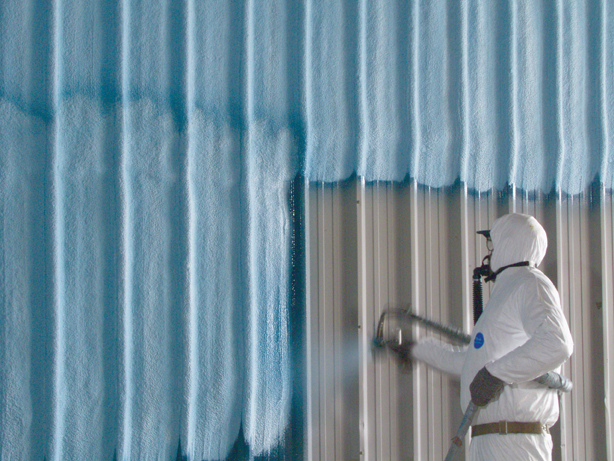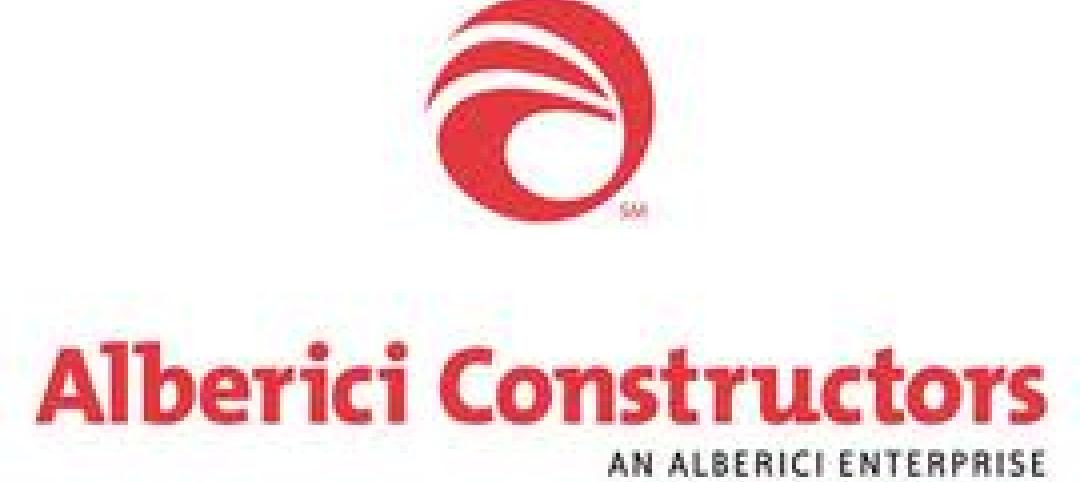In the nonresidential sector, spray polyurethane foam (SPF) has been used most often for re-roofing existing buildings. While SPF is hardly a new product (it’s been around for at least 35 years), the applications for both open-cell and closed-cell foam have been growing steadily as Building Teams grasp its potential to improve energy efficiency, interior comfort and durability in all types of structures.
Demand for SPF is increasing in both new construction and retrofit applications in North America, says Brian Troy, commercial market manager for Icynene. “On the new construction side, the increase can be quantified by the sheer number of new specifications coming out every day, calling for SPF within the published construction documents,” he says.
LEED certification is also pushing more architects, contractors, and developers to use spray foam in the walls and building envelope as well as on the roof, says Michael Sievers, business manager for spray polyurethane foams at BASF Corp. That’s because SPF has multiple attributes, notably air sealing, thermal performance, and structural performance. “Instead of being a niche product, it’s becoming more of a mainstream product,” says Sievers.
The introduction of renewable-based SPF products that reduce the need for petroleum-based polyols has probably had the most significant impact on commercial applications, as architects, designers and building owners look for additional opportunities toward total point contributions on LEED-registered projects. This is especially true for government facilities that must comply with mandates for energy efficiency. “Spray foam is 25-30% more energy efficient because it’s seamless and monolithic, so it’s often used in building retrofits,” says Rick Tucker, global business manager for Honeywell’s TerraStrong, a closed-cell SPF.
Because spray foam is often 10-15% more expensive than other types of insulation, it’s sometimes used in combination with products such as rigid board insulation in order to achieve higher R-values. “If you want R-20 or R-30, you can use board stock on the exterior and foam on the interior,” says Tucker. “It’s an effective way to reduce or eliminate thermal bridging.”
Let’s take a look at some recent projects where Building Teams—and their clients—benefited from using SPF.
THE SEARCH FOR ‘ULTRA-INSULATION’
For the New Century International Elementary School in Cumberland County, N.C., SfL+a Architects, Raleigh, N.C., wanted the project to be more than just another LEED Platinum building: They wanted it to serve as a model for future buildings that will save their owners millions of dollars in the long term. The school is designed for net-zero energy use, meaning that it will generate more energy than it consumes. Among the sustainable features is a closed-loop geothermal HVAC system, solar panels that will generate electricity and heat water, controlled lighting systems, and NCFI’s InsulBloc spray foam insulation for the building envelope.
“We wanted ultra-insulation, air and vapor barriers in a single product,” says Robert W. Ferris, AIA, REFP, LEED AP, CEO and president of SfL+A. “With board insulation, there are a lot of joints that have to be taped to prevent water from entering. Foam eliminates all the joints. The primary benefits are increased R-values and decreased infiltration losses, and we get a nice waterproofing over our block.”
EXTRA : Spray Foam Insulation Trends |
At 175-185 Wyman Street, a new corporate campus in Waltham, Mass., Columbia Construction Co., North Reading, Mass., used NCFI’s InsulBloc for the first time in conjunction with a terra cotta rainscreen system. The project consists of two buildings with a variety of exterior surfaces, including metal, terra cotta, and precast concrete. The owner is seeking LEED Gold certification.
“Moisture can get in behind the terra cotta wall panels, but it drains out at the bottom,” explains Sam Dettore, a senior project manager with Columbia. “The spray-on insulation, which becomes inert—a block of insulation behind that terra cotta—is preferable because it’s resistant to any kind of moisture that might get into the wall.”
Dettore says two different methods were used to apply the NCFI product. For the metal exteriors, foam was sprayed onto an air and vapor barrier and the metal panels were installed over that. Sanford Contracting, North Billerica, Mass., prefabricated the wall panels for the terra cotta exteriors. “Sanford assembled the walls and applied the foam and terra cotta in their warehouse, then delivered the panels to the job site and hung them in place on the steel superstructure of the building,” says Dettore.
A recent inspection by Columbia Construction showed that InsulBloc is living up to expectations. “We’ve gone through an entire cycle of weather that you can have in New England, and it’s resisted any kind of cracking or twisting,” says Dettore.
MORE DEMAND FOR LOW-PRESSURE FOAM
In commercial buildings, contractors use high-pressure foam—sprayed out of a rig at more than 1,000 psi—to create a monolithic exterior insulation layer. But low-pressure foam also has its uses in commercial construction, says Tom Fishback, vice president of R&D for Fomo Products, whose spray foam is dispensed from portable kits at 200 psi.
“Probably the greatest demand for low-pressure spray foam in commercial buildings, both new construction and retrofit, is at the roof/wall juncture,” says Fishback. “That juncture is often not air-sealed. Even in new buildings, the usual practice is to stuff fiberglass insulation into the cavity in a non-fire-rated wall. The width of that gap can be six inches, and it allows cold air and pollutants to come through from outside.”
Fishback says some contractors have started sealing roof/wall junctures with Fomo’s low-pressure foam, dispensing it to a depth of two inches. He says this results in an R-value of 12.
The retrofit market is another strong one for low-pressure foam. In New York City, for example, old factories and warehouses are being converted to loft condominiums and the exterior cladding of old public schools is being stripped off and replaced. Low-pressure foam has proven very effective in sealing the gaps between windows and walls. Those gaps, which can be up to four inches wide, are one of the greatest ingress points for moisture and air, Fishback says. Applying a Class A, two-component spray foam to the gaps gives the insulation an R-value of 6.2 per inch.
One more benefit of spray foam insulation: acoustics. SPF has proven to be an effective sound barrier in office conference rooms where noisy presentations or webcasts may take place. “There’s a lot of noise emanating from those rooms to adjacent offices,” says Fishback. “Open-cell foam is very easy to apply, and it creates a good monolithic layer on interior walls.”
Related Stories
| Apr 19, 2012
HBD Construction names Steven Meeks vice president
Meeks will provide expertise for the company in its many diverse areas of construction projects including health care, senior living, education and retail.
| Apr 17, 2012
Princeton Review releases “Guide to 322 Green Colleges”
The guide profiles 322 institutions of higher education in the U.S. and Canada that demonstrate notable commitments to sustainability in their academic offerings, campus infrastructure, activities and career preparation.
| Apr 17, 2012
FMI report examines federal construction trends
Given the rapid transformations occurring in the federal construction sector, FMI examines the key forces accelerating these changes, as well as their effect on the industry.
| Apr 17, 2012
Alberici receives 2012 ASA General Contractor of the Year award
Alberici has been honored by the ASA eight times in the award’s nineteen-year history--more than any other general contractor in its class.
| Apr 16, 2012
Freeland promoted to vice president at Heery International
Recently named to Building Design+Construction’s 40 Under 40 Class of 2012.
| Apr 16, 2012
University of Michigan study seeks to create efficient building design
The result, the researchers say, could be technologies capable of cutting the carbon footprint created by the huge power demands buildings place on the nation’s electrical grid.
| Apr 16, 2012
UNT lab designed to study green energy technologies completed
Lab to test energy technologies and systems in order to achieve a net-zero consumption of energy.
| Apr 16, 2012
$80 million in export financing for solar project in India
The project, “Rajasthan Sun Technique Energy Private Limited,” is a subsidiary of Reliance Power and is being co-financed by the Asian Development Bank and FMO, the Dutch development bank.
| Apr 13, 2012
Goettsch Partners designs new music building for Northwestern
The showcase facility is the recital hall, an intimate, two-level space with undulating walls of wood that provide optimal acoustics and lead to the stage, as well as a 50-foot-high wall of cable-supported, double-skin glass
| Apr 12, 2012
Solar PV carport, electrical charging stations unveiled in California
Project contractor Oltman Construction noted that the carport provides shaded area for 940 car stalls and generates 2 MW DC of electric power.















